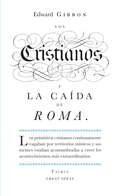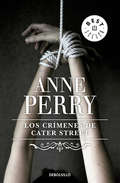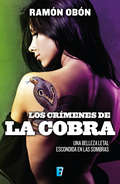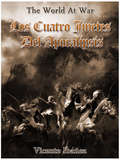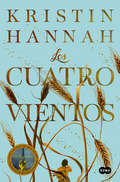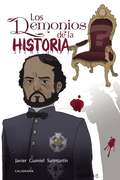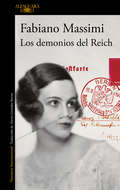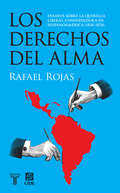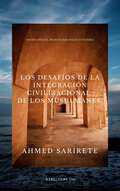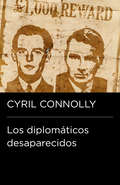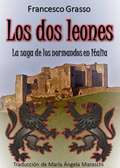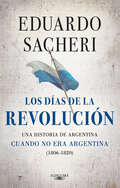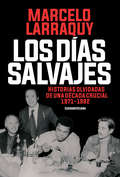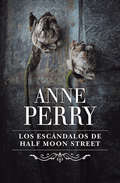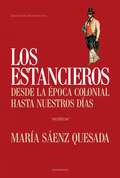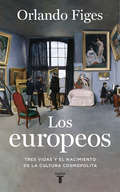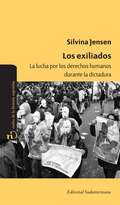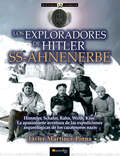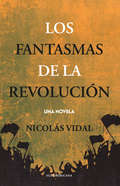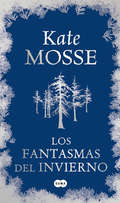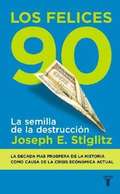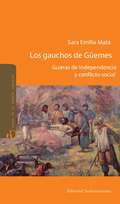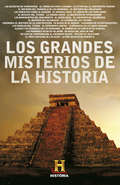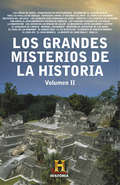- Table View
- List View
Los cristianos y la caída de Roma (Serie Great Ideas #Volumen 22)
by Edward GibbonIdeas que han cambiado el mundo. A lo largo de la historia, algunos libros han cambiado el mundo. Han transformado la manera en que nos vemos a nosotros mismos y a los demás. Han inspirado el debate, la discordia, la guerra y la revolución. Han iluminado, indignado, provocado y consolado. Han enriquecido vidas, y también las han destruido. Taurus publica las obras de los grandes pensadores, pioneros, radicales y visionarios cuyas ideas sacudieron la civilización y nos impulsaron a ser quienes somos. La descripción subversiva e iconoclasta que Gibbon realizó del ascenso del cristianismo suscitó la más encendida indignación cuando vio la luz a finales del siglo XVIII y continúa siendo una de las más elocuentes e irrefutables críticas de la naturaleza engañosa de la fe. Comentarios sobre la colección Great Ideas:«De veras que la edición es primorosa y pocas veces contenido y continente pueden encontrarse mejor ensamblados y unidos. ¡Qué portadas! Para enmarcar. [...] Ante las Great Ideas, solo cabe quitarse el sombrero. ¡Chapeau!»ABC «Taurus propone un doble envite con este lanzamiento. Por un lado aumenta su compromiso con el ensayo; por otro, recupera el gusto por la estética. A los volúmenes se les ha proporcionado una portada delicada y cuidada (copian el original británico) que invita a la lectura.»La Razón «Un fenómeno editorial.»The Guardian «Aparte de los contenidos, en general muy bien elegidos, son tan bonitos que si los ven seguro que cae alguno.»El País «Ideas revolucionarias, crónicas de exploraciones, pensamientos radicales... vuelven a la vida en estas cuidadísimas ediciones, muy atractivas para nuevos lectores.»Mujer Hoy «Grandes ideas bien envueltas. De Cicerón a Darwin, esta colección entra por los ojos.»Rolling Stone «Original y bella iniciativa la emprendida por Taurus con su colección Great Ideas.»Cambio 16 «Hay libros inmortales, libros únicos que contienen pensamientos y reflexiones capaces de cambiar el mundo, tesoros en miniatura reagrupados en la colección Great Ideas.»Diario de León
Los crímenes de Cater Street (Inspector Thomas Pitt #Volumen 1)
by Anne PerryLa primera novela de la serie del inspector Pitt Un terrible crimen cruzará los caminos de una inteligente y aristocrática joven y un perspicaz inspector en el neblinoso Londres del s. XIX. Con Los crímenes de Cater Street Anne Perry inicia la serie de novelas que tienen por protagonista al inspector Thomas Pitt, un discreto policía londinense destinado a desentrañar, en plena época victoriana, los horrendos crímenes perpetrados por una sociedad reprimida e hipócrita. En esta ocasión un barrio de clase acomodada se ve sacudido por un sanguinario asesino. Las víctimas son siempre mujeres jóvenes que aparecen brutalmente estranguladas. En su investigación, Pitt encuentra el apoyo de Charlotte Ellison, una encantadora muchacha disconforme con las rígidas actitudes de su clase social.
Los crímenes de la cobra: Una belleza letal escondida en las sombras
by Ramón ObónEl descubrimiento de una cobra de oro en un cenote maya es el gatillo que detona la codicia y la violencia. El extraño objeto, perteneciente a la cultura tailandesa, provoca que fuerzas oscuras muevan sus tentáculos para descubrir un secreto ancestral.
Los cuatro jinetes del apocalipsis: Centenario De La Primera Guerra Mundial (The World At War #425)
by Vicente IbáñezSe trata de una novela ambientada en 1914 en Francia y narra las vicisitudes de la Primera Guerra Mundial. El punto de vista es el de un natural de un país neutral aunque claramente decantado por el lado francés de los Aliados frente a Alemania. Debido a sus diferencias políticas, dos familias provenientes de un tronco común, los Desnoyers y los Von Hartrott, se enfrentan. Tras la muerte del patriarca, Julio Madariaga, los Hartrott se marchan a Alemania y los Desnoyers a Francia. Ambas familias terminan combatiendo en bandos opuestos en la Primera Guerra Mundial. La novela discurre ágilmente por los escenarios dantescos de una Europa rota, sobre cuyos desolados campos de batalla el gran vitalista que fue Blasco hace latir finalmente, salvaje e invencible, el deseo de vivir.
Los cuatro vientos
by Kristin HannahDe la autora de El Ruiseñor, una épica y emocionante novela de amor, heroísmo y esperanza. Texas, 1921. La Gran Guerra ha terminado y Estados Unidos parece entrar en una nueva era de optimismo y abundancia. Pero para Elsa, considerada demasiado mayor para casarse en una época en la que el matrimonio es la única opción de una mujer, el futuro es incierto. Hasta la noche en que conoce a Rafe Martinelli y decide cambiar la dirección de su vida. Con su reputación arruinada, solo le queda una opción respetable: casarse con un hombre al que apenas conoce.En 1934, el mundo ha cambiado. Millones de personas se han quedado sin trabajo y los granjeros luchan por conservar sus tierras. Las cosechas se pierden por la sequía, las fuentes de agua se secan y el polvo amenaza con enterrarlo todo. Cada día en la granja de los Martinelli es una desesperada batalla por la supervivencia. Y, como tantos otros, Elsa se ve obligada a tomar unaagónica decisión: luchar por la tierra que ama o marchar al oeste, a California, en busca de una vida mejor para su familia. *Número 1 en la lista de más vendidos de The New York Times*Número 1 en la lista de más vendidos de USA Today *Número 1 en la lista de más vendidos de The Wall Street Journal*Una de «Las novedades más esperadas de 2021» -Newsweek*Una de «Las 27 novelas de ficción histórica más esperadas de 2021 que te atraparán» -Oprah Magazine*Uno de «Los libros más esperados de 2021» -Parade*Uno de «Los libros de los que hablará todo el mundo en 2021» -PopSugar*Uno de «Los 57 libros más esperados de 2021» -Elle*Uno de «Los 32 grandes libros para comenzar el año» -Refinery29*Uno de «Los 25 mejores libros que llegarán en 2021» -BookBub*Uno de «Los libros más esperados de 2021» -Frolic Reseñas:«Brutalmente hermosa.»Newsweek «Una fascinante historia de amor, coraje y sacrificio... Combina un crudo realismo con personajes llenos de riqueza emocional y una prosa lírica que suena esperanzadora y auténtica desde la primera línea.»Publishers Weekly «Excepcional... Una novela rica y gratificante sobre vínculos familiares, perseverancia y la amistad y fortaleza de las mujeres.»Booklist «Los cuatro vientos resulta sobrecogedoramente profética con su historia sobre la Gran Depresión, de tierras arrasadas, xenofobia, y miedo al contagio… y también de la determinación para unir fuerzas y reconstruir. Su mensaje es estimulante y esperanzador.»The New York Times «Épica y evocadora, una conmovedora historia de amor y dificultades... Majestuosa y absorbente.»USA Today «Por encima de todo lo demás, Los cuatro vientos es una muy buena historia, una historia que toca todas las teclas correctas y que te sorprende hasta el final.»Associated Press
Los cuentos de Betania: Cuatro Historias Entrelazadas de Recuperación y Esperanza
by Bryan E. CanterUna mujer joven, explusada por su padre y rechazada por su familia, deambula por las calles de Jerusalén... ... vendiendo su cuerpo para sobrevivir en una ciudad despiadada que no tiene piedad por los oprimidos. Cuando un hombre le promete un modo de vida diferente, ella supera sus dudas y le abre su corazón. Un extraño llamado Jesús salva a María de la muerte, y ella se convierte en una seguidora devota. Él la ayuda a liberarse de una vida de prostitución, y viajan a su pueblo natal de Betania para buscar reconciliarse con su familia. Su hermano Lázaro acepta con alegría su regreso, pero su hermana y su tío dejan muy en claro que ella no es bienvenida ahí. Frente al rechazo de su hermana y el orgullo crítico de su tío, María cuestiona el perdón de Dios y lucha por perdonarse a sí misma. Sin embargo incluso cuando sus vidas se entrelazan y chocan, los mismos que se apresuran a condenarla, luchan con sus propios demonios internos -ineptitud, arrogancia, y la necesidad de ganar el favor de Dios. ¿Estas actitudes destrozarán a su familia para siempre, o puede un carpintero de Nazaret abrir sus ojos incrédulos y mostrarles la maravilla de la verdadera fe?
Los demonios de la historia
by Javier Gumiel SanmartínEl relato de unos hechos que cambiaron la Historia de España de finales del Siglo XIX y del XX. Los demonios de la Historia es la continuación de La Sangre de Caín y relata los acontecimientos históricos producidos en España entre Octubre de 1868, apenas triunfante la Revolución de Septiembre, La Gloriosa, y el asesinato, nunca esclarecido totalmente del general Prim, que cambió de una forma indiscutible la Historia de España y, en alguna medida, de Europa. <P><P>A través de sus páginas se desvelan las costumbres y el ambiente del Madrid de la época. Se conocen las pautas por las que se regían los duelos y se entra en el interior de una Logia masónica, con la descripción de sus ritos y su jerarquía. <P>Entre todos esos acontecimientos discurre la vida de Mariano Pereantón, desarrollando su trabajo como periodista para el diario republicano La Discusión, especialmente como cronista de las sesiones de las Cortes..
Los demonios del Reich
by Fabiano MassimiUn electrizante thriller histórico basado en hechos reales, por el aclamado autor ganador del Premio Asti d'Appello con El ángel de Munich, comparado con Ken Follett, Número 1 en ventas en Italia y «uno de los thrillers del año» (Juan Carlos Galindo, El País) «Un escritor que conjuga la erudición de un historiador, las fuentes de un periodista y la capacidad narrativa de un novelista.» Juan Losa, Público Corre el mes de febrero de 1933 en Berlín. Ante el edificio del Parlamento en llamas, el ministro de Propaganda del Tercer Reich, Joseph Goebbels, se dispone a hacer unas declaraciones a la prensa. Unos días antes, Siegfried Sauer, que había huido a Viena junto a Rosa, se encuentra en su casa con el agente doble Karl Julian. Hace dos meses que Sauer no sabe nada de su pareja: ella ha vuelto a Alemania para unirse a la resistencia y tratar de dinamitar el partido nazi desde dentro, pero cuando Julian le enseña una postal que ha recibido con una foto de Múnich y una cita del Cantar de los Nibelungos —«Cava una fosa y siéntate en su interior»—, entiende que se trata de un mensaje para él: Rosa está en peligro. Sauer viajará clandestinamente a Berlín, una ciudad plagada de camisas pardas, clubes nocturnos, fiestas secretas en la que no puede fiarse de nadie y donde se suceden misteriosos asesinatos de mujeres, todas ellas muy parecidas a Rosa. La crítica ha dicho...«Una página de la historia del siglo XX poco investigada, pero considerada un hito fundamental por los historiadores y de la que ahora se encarga la narrativa.»La Repubblica «Una novela capaz de tocarnos la fibra, con tramas que se entrelazan y, como telón de fondo, un periodo de incomparable interés histórico: la Alemania de entreguerras, un país presa del populismo,devastado por una polarización ideológica y una violencia extremas sobre las que fundamenta su poder. Un cuadro que encuentra un trágico reflejo también en la sociedad occidental contemporánea.»Ildefonso Falcones, Corriere della Sera «Preciso, imaginativo y brillante.»Donato Carrisi, Corriere della Sera «De la Historia solo se aprende investigando. […]Unos secretos muy importantes escondidos tras un thriller histórico. […] Un sutil hilo conductor que une [Massimi] a las novelas de Kafka y que, en sus relatos de la vida y de los sentimientos durante la formación del pangermanismo, vuelve a revivir a un pueblo muerto y a sus verdugos, recordándonos que no es la gente la que escribe la Historia, sino quien sabe controlarla.»Roma
Los derechos del alma. Ensayos sobre la querella liberal-conservadora en Hispanoamérica (1830-1870): Ensayos sobre la querella liberal-conservadora en Hispanoamérica (1830-1870)
by Rafael RojasLa guerra armada en las nacientes repúblicas hispanoamericanas tuvo su paralelo en el mundo de las ideas. Ésta es su historia.Este libro aborda las disputas intelectuales que acompañaron a las guerras civiles entre liberales y conservadores en Hispanoamérica, a mediados del siglo XIX. Entre 1830 y 1870, las repúblicas que nacieron tras la caída del imperio español en América, se vieron divididas por visiones opuestas de la sociedad y el Estado, que representaban intereses e ideales de diversos sectores de aquellas naciones en formación.Mientras los liberales aspiraban a una sociedad compuesta por ciudadanos propietarios, que eliminara los últimos privilegios heredados del antiguo régimen, los conservadores intentaban preservar el poder de la Iglesia y el orden jerárquico heredado de los virreinatos. La división de aquellas sociedades las condujo a la guerra militar y una lucha ideológica no menos feroz. Los ejércitos se enfrentaban en el campo de batalla y los intelectuales de cada bando, en la literatura y el periodismo.El eje de la discordia era la doctrina de los derechos naturales del hombre. Distintas versiones en torno a esta idea se enfrentaron a dilemas prácticos de la vida pública como la propiedad de la Iglesia, su papel en la educación, la libertad de expresión, la esclavitud, el sufragio, la división de poderes, los códigos civiles y el derecho canónico. Este libro ofrece un panorama de aquellos debates, que fundaron las tradiciones ideológicas fundamentales del siglo XIX hispanoamericano.
Los desafíos de la integración civilizacional de los musulmanes
by Ahmed SarireteDado que el mundo se interesa cada vez más a los comportamientos de los musulmanes, y que todas las miradas desconfiadas apuntan sobre el origen de su cultura que es el islam, este ensayo está destinado en primer lugar a los musulmanes para darles nuevos elementos de reflexión para que puedan revisar su visión del mundo al mismo tiempo que su verdadero papel esperado en el concierto de las naciones. Como también está destinado a cualquiera, que muestre un interés a la cultura de la fe y al islam en particular, con el fin de aclarar e invitarle a más comprensión, y a la vez cambiar su actitud de desconfianza hacia la gente de esta nación de fe.
Los diplomáticos desaparecidos (Colección Endebate #Volumen)
by Cyril ConnollyLa crónica de la misteriosa desaparición de los dos primeros miembros del círculo de Cambridge. El 25 de mayo de 1951, Guy Burgess y Donald Maclean, dos funcionarios británicos, desaparecieron sin dejar rastro y dieron inicio al mito de los cinco de Cambridge, los brillantes jóvenes captados por la inteligencia soviética en el Cambridge de los años treinta. Aun conmocionado por la desaparición, y mucho antes de que la Unión Soviética admitiera que les había cogido, Cyril Connolly escribió este fascinante y perspicaz retrato de los dos, intentando adivinar qué había pasado con los diplomáticos que desaparecieron.
Los dos leones: La novela de Roberto y Ruggero de Altavilla. La saga medieval de los normandos en Italia
by Francesco GrassoLos dos leones, por Francesco Grasso La novela de Roberto y Ruggero de Altavilla La saga medieval de los normandos en Italia Alba del segundo milenio. Dos hermanos, Roberto y Ruggero, dejan el pequeño pueblo de Hauteville, en la región francesa que justo en ese momento comienza a ser llamada Normandía, y se dirigen hacia el sur de Italia. Tienen con ellos una espada, un caballo y una ambición desmesurada. Roberto gracias a una astucia luciferina que será legendaria, Ruggero a través de una fuerza física excepcional y una fe inquebrantable que va más allá del misticismo. Vencerán a sus enemigos, se transformarán en líderes poderosos y temidos, moverán ejércitos y conquistarán un trono. Se verán enfrentados por deseos de dominación y por el amor de una misma mujer. Porque si es verdad que dos leones pueden cazar juntos, uno solo puede dirigir la manada. Esta novela es la primera de una saga dedicada a la epopeya de los normandos en Italia.
Los días de la Revolución (1806 - 1820): Una historia de Argentina cuando no era Argentina
by Eduardo SacheriUna historia de Argentina... cuando no era Argentina. El primer libro de historia de Eduardo Sacheri. Querido lector: Te preguntarás por qué me pongo a escribir un libro de Historia cuando todos los míos anteriores son ficciones, es decir, historias inventadas. Y es que antes de empezar a escribir ficción estudié Historia. Obtuve mis títulos de profesor y de licenciado y me dediqué durante muchos años a enseñar en la universidad y en escuelas secundarias. De hecho, sigo enseñando. ¿Por qué, además, quise escribir un libro? En las últimas décadas la investigación histórica se ha renovado mucho en la Argentina, con preguntas nuevas y aproximaciones mucho más ricas y diversas que antes. Y sin embargo esos trabajos no han conseguido, en general, abrirse paso en el sentido común más o menos compartido por la sociedad. Al contrario: siguen muy vigentes, en esa "agenda pública", discursos históricos moralizadores, que no se proponen comprender sino juzgar y que simplifican nuestra perspectiva con anacronismos y visiones épicas que dificultan nuestra posibilidad de entender ese pasado colectivo. Por eso es importante que los que enseñamos Historia hagamos lo posible por facilitar el encuentro entre el trabajo académico más serio y actualizado y la sociedad a la que ese trabajo está destinado. Creo que esa es una de las principales funciones de quienes nos dedicamos a la docencia. En Los días de la Revolución, mi primer libro de Historia, vas a encontrarte con una posible explicación del proceso revolucionario que sacude y derrumba el Virreinato del Río de la Plata entre 1806 y 1820. La Argentina no "nace" automáticamente de ese proceso. Al contrario: es producto de una larga, accidentada y compleja evolución. Pero es cierto que algunas de las claves de esa construcción hunden sus raíces en esos tiempos revolucionarios, en esas personas, en esas circunstancias y en esas peripecias. Y aquellos años de principios del siglo XIX, cuando el Imperio Español estalla en pedazos, habitan también en nosotros, en lo que somos en el siglo XXI. Este libro es una invitación a explorar juntos esos vestigios cargados de significado.Eduardo Sacheri
Los días salvajes: Historias olvidadas de una década crucial 1971-1982
by Marcelo LarraquyRelatos que repercutieron en los medios y la opinión pública de la década del setenta, pero no tuvieron la misma difusión que los hitos violentos -asesinatos, desapariciones y atentados- de esos años. Desde fines de los sesenta hasta comienzos de los ochenta del siglo pasado, la Argentina vivió uno de los períodos más traumáticos de su historia. Esos años fueron estudiados, analizados y revisados exhaustivamente, sin embargo, existen todavía historias disueltas en la memoria o desconocidas. Los días salvajes se propone rescatarlas. Entre ellas están la pulseada de Muhammad Ali y José Rucci en una fábrica del Conurbano, los entretelones de la candidatura de Héctor Cámpora, el protocolo redactado por las Fuerzas Armadas para dar el golpe de Estado, la detenida-desaparecida que llamaba a sus padres durante la democracia, las topadoras que destruyen el barrio de René Houseman mientras el goleador se prepara para jugar el Mundial 78, el naufragio del buque mercante argentino impactado por los ingleses en Malvinas. Célebre por las biografías de personajes emblemáticos (López Rega y Galimberti) y la investigación de la historia violenta del país, Marcelo Larraquy recupera eventos perdidos en el relato de esa década. Y afirma: "Los treinta episodios de este libro pueden parecer dispersos o dispares, pero una fuerza ciega los reúnen a todos. La fuerza de las expectativas colectivas no resueltas. La fuerza de las ideas y de las ilusiones, de los odios. La fuerza del miedo, de las tragedias, de lo que se quiso y no se pudo. De lo que se padeció".
Los escándalos de Half Moon Street (Inspector Thomas Pitt #Volumen 20)
by Anne PerryUn cadáver sin identificar, un escalofriante asesinato, un crimen movido por la pasión y el brillante escenario de la Inglaterra victoriana son los ingredientes de este nuevo desafío para el inspector Thomas Pitt. La vigésima novela de la serie del inspector Pitt El inspector Thomas Pitt no puede identificar de inmediato a qué estrato social pertenece un hombre cuyo cadáver ha sido encontrado en una barca totalmente a la deriva en el Támesis, pero la visión es imborrable: yace en una embarcación destartalada, con brazos y piernas encadenados, ataviado con un vestido de mujer desgarrado y rodeado de guirnaldas de flores. ¿Se trata, como teme Pitt, de un diplomático francés desaparecido? ¿O tan solo de alguien que se le parece extraordinariamente? La exhaustiva investigación de Pitt le obliga a adentrarse en el mundo bohemio londinense, desde los ambientes de teatro hasta los estudios donde los maestros de la luz y la sombra experimentan con el fascinante y nuevo arte de la fotografía. Una vez más, Anne Perry ahonda en los crímenes movidos por la pasión y nos ofrece un brillante retrato de la sociedad londinense victoriana: resonar de cascos de caballos sobre los adoquines, elegantes salones de té, escándalos inconfesables, secretos de alcoba y, en fin, el fuerte latido de una ciudad esplendorosa. La crítica ha dicho... «Sugerente... Impactante... El desarrollo es pura tensión, con giros inesperados y con la pulcritud y la inteligencia que hacen de Perry la reina del misterio histórico inglés.» The Chicago Tribune
Los estancieros: Desde la época colonial hasta nuestros días
by María Sáenz QuesadaDesde los pioneros del poblamiento rural hasta la época de «las vacasgordas» (1914), este libro aborda las distintas etapas en la proyecciónnacional de los estancieros, sus formas de vida, sus vínculos con laciudad y con las clases dominantes, los modos de apropiación de latierra, lo que se dijo de ellos, lo que pensaron de sí mismos. Admirados en sus orígenes, denostados más tarde, pocos tienen una ideaclara de cómo es y cómo ha sido uno de los grupos más poderosos de laArgentina, los estancieros de la pampa húmeda. A través de materialespúblicos, cartas, crónicas de viajes, textos literarios y entrevistas,María Sáenz Quesada construyó de manera novedosa y original en estaobra, publicada por primera vez en 1980, una pintura vívida de un sectorrelegado de nuestra tradición pero ineludible para nuestros presente yfuturo. En esta edición, revisada y actualizada, la autora retoma eltema agropecuario desde comienzos del siglo XX hasta nuestros días, consus crisis, sus transformaciones y sus desafíos tecnológicos. Incluyereportajes inéditos y el enfrentamiento con el Gobierno de Kirchner porlas retenciones, que puso en discusión, una vez más, el rico y diversoimaginario cultural en torno al campo.
Los europeos: Tres vidas y el nacimiento de la cultura europea
by Orlando FigesUna obra deslumbrante que rastrea los orígenes de la cultura europea de todo el continente, por el aclamado historiador Orlando Figes, un «maestro de la narrativa histórica» (Financial Times). El siglo XIX europeo, un momento de logros artísticos sin precedentes, fue la primera era de la globalización cultural, una época en que las comunicaciones masivas y los viajes en tren de alta velocidad reunieron a Europa, superando las barreras del nacionalismo y facilitando el surgimiento de un verdadero canon europeo de obras artísticas, musicales y literarias. Llegado 1900, se leían los mismos libros, se reproducían las mismas obras artísticas, se representaban las mismas óperas y se interpretaba la misma música en los hogares y se escuchaba en las salas de conciertos a lo largo de todo el continente. Partiendo de una gran cantidad de documentos, cartas y otros materiales de archivo, el aclamado historiador Orlando Figes examina cómo fue posible esta unificación. En el centro del libro hay un triángulo amoroso conmovedor: Ivan Turgenev, el primer gran escritor ruso en convertirse en una celebridad europea, Pauline Viardot, de origen español, una de las cantantes de ópera más famosas del mundo, además de compositora y profesora de canto, y Louis Viardot, director de teatro, activista republicano y gran experto en arte(autor de las primeras guías de grandes museos del mundo, el Prado entre otros)y esposo de Pauline, por cuya carrera musical sacrificó parte de la suya. Juntos, Turgenev y los Viardot estuvieron en el centro del intercambio cultural europeo: conocían o se cruzaban con Delacroix, Berlioz, Chopin, Brahms, Liszt, Schumann, Hugo, Flaubert, Dickens y Dostoyevski, entre muchas otras figuras destacadas. Como observa Figes, casi todos los grandes avances de la civilización se han producido durante los períodos de mayor cosmopolitismo, cuando las personas, las ideas y las creaciones artísticas circulan libremente entre las naciones. Vívido y perspicaz, L os europeos muestra cómo ese fermento cosmopolita fraguó tradiciones artísticas que llegaron a dominar la cultura mundial.
Los exiliados: La lucha por los derechos humanos durante la dictadura
by Silvina Ines JensenDe la colección Nudos de la Historia argentina, esta obra narra lahistoria de los exiliados políticos, aquellos que los militarescalificaban de «subversivos derrotados y en fuga», protagonistas de lalucha antidictatorial que intentaron convertirse en puentes con losmiles de otros argentinos que vivían «sojuzgados por la represión y lacensura que no podían hacer conocer al mundo el genocidio». ¿Cuáles fueron las relaciones entre los militares golpistas de 1976 ylos exiliados argentinos? ¿Por qué la denuncia exterior de la dictadurase definió en términos de defensa de los derechos humanos? ¿Qué hitosmarcaron las luchas entre los exiliados y el gobierno castrense a lolargo del «Proceso de Reorganización Nacional»? ¿En qué medida la visitade la Comisión Interamericana de Derechos Humanos de la OEA enseptiembre de 1979 fue un momento bisagra en el cerco exterior delrégimen y en el esclarecimiento de la situación de los «desaparecidos»?Haciendo foco en la visita de la CIDH, el libro responde acuestiones fundamentales que atraviesan la historia argentina endictadura, dentro y fuera de las fronteras del país, no solo permitiendocomprender las luchas entre el régimen y sus opositores, sino tambiéniluminando las tensiones, contradicciones, complejidades y debates en elcampo de los «derrotados».Para la colección Nudos de la historia argentina hemos pedido ahistoriadores de primer nivel que escriban libros sólidos pero a la vezatractivos, susceptibles de ser leídos y disfrutados por personasinteresadas en la historia, aunque carezcan de una formaciónuniversitaria en la disciplina. Esperamos estar a laaltura del desafío.
Los exploradores de Hitler: SS-AHNENERBE (Historia Incógnita)
by Javier Martínez-PinnaHimmler, Schafer, Rahn, Wirth, Kiss: La apasionante aventura de las expediciones arqueológicas de los cazatesoros nazis. Con Los exploradores de Hitler, Javier Martínez-Pinna vuelve a introducir al lector en la apasionante aventura de encontrar alguno de los tesoros ocultos más anhelados de nuestro pasado, esta vez siguiendo la pista a los investigadores nazis que durante años recorrieron el mundo al servicio del Tercer Reich. En su nuevo libro, se narra de manera ágil y amena la historia de las expediciones patrocinadas por la Ahnenerbe, una organización integrada dentro de las temibles SS, para encontrar las huellas perdidas de la raza aria, en las lejanas e inaccesibles cumbres del Tíbet, o la enigmática ciudad peruana de Tiahunaco. A través de sus páginas seguiremos el rastro de este extraño grupo de aventureros que se puso al servicio de un régimen que les encargó la búsqueda de los más poderosos objetos de culto de todas las religiones. Esta es su historia.
Los fantasmas de la revolución
by Nicolás VidalLa historia novelada de uno de los personajes más fascinantes y controvertidos de la historia política chilena reciente. ¿Héroe o asesino? Ricardo Palma Salamanca es uno de los personajes más atractivos a la vez que más polémicos de nuestra historia reciente. El joven idealista que se transformó en militante de un grupo subversivo en la lucha contra la dictadura de Augusto Pinochet, para terminar involucrado en algunos de las acciones más radicales de su organización. Además de ser el autor de las muertes de un coronel de carabineros y de un sargento del ejército, participó en el secuestro de Cristian Edwards, entonces joven empresario e hijo del dueño de El Mercurio y terminó siendo el ejecutor de la orden de asesinar a Jaime Guzmán, ideólogo de la dictadura, pero a quien en un principio se negó matar. Luego de una espectacular fuga en helicóptero desde la cárcel de alta seguridad, vivió otra vida en la clandestinidad en México, donde ejercía como fotógrafo y tenía una galería de arte junto a su pareja. Descubierto, huye a Francia, donde lucha para evitar la extradición a Chile.
Los fantasmas del invierno
by Kate Mosse¿Crees en los fantasmas? Corre el año 1928. Freddie Watson todavía lamenta la pérdida de su hermano, el cual falleció en la Gran Guerra. Mientras Freddie se adentra con su coche entre las montañas de los Pirineos franceses, sufre un accidente provocado por una fuerte tormenta de nieve. Freddie se refugia en un cercano pueblo abandonado, donde se encuentra con una hermosa y cautivadora mujer. Se pasan toda la noche charlando animadamente de amor, de pérdidas y de la guerra. Pero cuando amanece, Fabrissa ha desaparecido y Freddie se da cuenta de que porta una llave que abre un antiguo misterio que le arrastrará a la profundidad de las montañas, a una cueva en la que ese misterio ha permanecido oculto durante más de 700 años. Las tierras misteriosas y secretas que se extienden junto a la frontera de Francia y España no sólo sirven como telón de fondo de la novela, también han visto mucho derramamiento de sangre a lo largo de miles de años, son una parte del mundo en la que la prehistoria, la mitología y la historia se funden en la suerte de escenario vacío inspirador de Los fantasmas del invierno. Kate Mosse nos brinda además una historia de amor atmosférica y fascinante, con un tono de misterio, de especulación sobrenatural, de un tiempo fuera del tiempo. Los fantasmas del invierno se sitúa en esa tradición de escalofriantes historias de fantasmas para leer en las oscuras y frías noches de invierno.
Los felices noventa
by Joseph StiglitzLa década de los noventa marcó el surgimiento de la nueva economía, caracterizada por unos incrementos de productividad que duplicaban o triplicaban lo conocido durante las dos décadas precedentes. Pero los felices noventa se acabaron bien pronto, antes incluso de que Bill Clinton abandonara la Casa Blanca. La economía entró en recesión y los escándalos empresariales destronaron a los sumos sacerdotes del capitalismo: daba la impresión de que los directivos de algunas empresas estaban lucrando a expensas de sus accionistas y empleados. La globalización, que tan recientemente se había saludado como el comienzo de un mundo nuevo, también parecía verse con malos ojos. La reunión de la Organización Mundial del Comercio celebrada en Seattle en 1999, que tenía por fin ahondar en la apertura del mundo, acabó en disturbios protagonizados por grupos preocupados por los efectos, a veces devastadores, que la globalización tiene sobre los más pobres. Es necesario arrojar nueva luz sobre lo que ocurrió esos años, acentuando la necesidad de reinterpretarlos. Existe una pugna ideológica entre quienes abogan por reducir al mínimo la intervención del Estado en la economía y quienes sostienen que el Gobierno debe asumir un papel importante no sólo para corregir las carencias y limitaciones del mercado, sino también para tender hacia un grado más alto de justicia social. Stiglitz se cuenta entre los segundos, y en este libro pretende explicar por qué está convencido de que, aun cuando los mercados centralicen el éxito de nuestra economía, si los dejamos operar solos no siempre funcionan como debieran. Esta obra no se limita a reescribir la historia económica de los noventa: es, en la misma medida, una historia del futuro, del punto en el que los países desarrollados se encuentran en este momento y de hacia dónde deberían tender para que la economía mundial llegue a un curso más justo y estable.
Los gauchos de Güemes: Guerras de independencia y conflicto social
by Sara Emilia MataDe la colección Nudos de la Historia argentina, el análisis de la guerracontra los realistas que comandó el mítico Güemes desde el norteargentino. ¿Cómo fueron recibidas en Salta las novedades producidas en Buenos Airesen mayo de 1810? ¿Por qué tuvo lugar en la provincia de Salta unaprolongada guerra contra los realistas? ¿Cuáles fueron las razones quellevaron a gran parte del campesinado salteño a tomar las armas? y ¿Por qué lo hicieron siguiendo a Martín Miguel de Güemes? Estas y otraspreguntas se contestan en este libro, analizando los complejos problemasque atravesaron a la sociedad salteña en las primeras y crucialesdécadas del siglo XIX. Para ello se estudian las características quepresentaba la sociedad de Salta a fines de la colonia y sus reaccionesfrente a los inicios del proceso revolucionario; la contrarrevoluciónalentada por las familias realistas y por la proximidad del ejército delRey enviado desde Lima; se analiza la insurrección rural que sostuvo lacausa de la «libertad americana»; y la construcción de los liderazgosemergentes en la resistencia a la ocupación realista y en particular elde Martín Miguel de Güemes, Jefe de la Vanguardia del Ejército Auxiliardel Perú y Gobernador de la Provincia de Salta a partir de 1815.Para la colección Nudos de la Historia argentina hemos pedido ahistoriadores de primer nivel que escriban libros sólidos pero a la vezatractivos, susceptibles de ser leídos y disfrutados por personasinteresadas en la historia, aunque carezcan de una formaciónuniversitaria en la disciplina. Esperamos estar a laaltura del desafío.
Los grandes misterios de la historia
by Canal Historia¿Existe la Atlántida? ¿Cómo se construyeron las pirámides de Egipto? ¿Dónde se encuentra el Santo Grial? ¿Por qué continúan produciéndose desapariciones en el Triángulo de las Bermudas? La historia está repleta de preguntas sin respuesta, inquietantes enigmas que han dejado perplejos a los investigadores más reputados, misteriosas leyendas que han perdurado a lo largo de los siglos e inexplicables sucesos que todavía hoy crean controversia en el ámbito científico. Pero por fin se descubre la verdad oculta detrás de esas incógnitas. Este libro analiza todas las versiones y todos los puntos de vista sobre los temas más controvertidos, hasta resolver qué hay de cierto y qué de legendario en ellos. Nunca hasta ahora se habían abordado las preguntas más famosas del pasado y el presenta de nuestra civilización con el rigor y la amenidad con que el equipo del prestigioso Canal Historia ha revisado estos treinta grandes misterios.Civilizaciones perdidas, tesoros ocultos, fenómenos inexplicables, personajes legendarios, leyendas nazis..., Los grandes misterios de la Historia es un libro apasionante y revelador, un estudio de referencia que ningún aficionado puede perderse. La crítica ha dicho...«Un ejercicio que busca la objetividad y ofrece una completa variedad de versiones sobre los enigmas, pensando tanto en profanos como en expertos.»Interviú
Los grandes misterios de la historia. Volumen II
by Canal HistoriaTras el éxito de Los grandes enigmas de la Historia, Canal Historia recopila nuevos enigmas en un volumen ameno y riguroso que hará las delicias de los aficionados a la divulgación histórica. ¿Fueron los vikingos los primeros en descubrir América?¿Cómo murió la rubia platino más sensual de la historia del cine?¿Cuál es el origen de la Inquisición?¿Qué causó la muerte de Houdini, el ilusionista más famoso de todos los tiempos?¿Quién trazó las líneas de Nazca y con qué propósito?¿Se encuentra enterrado en el-Amarna el tesoro olvidado de Akhenatón? La Historia está plagada de preguntas sin respuesta, de misterios sin resolver que han dejado perplejos a investigadores de todo el mundo y de sucesos inexplicables que aún hoy crean controversia. Tras la gran acogida que los lectores brindaron al primer volumen de Los grandes misterios dela Historia, con más de cien mil ejemplares vendidos, el canal temático más famoso a nivel mundial presenta veinticinco nuevos misterios que apasionarán a todos los aficionados. Con el rigor y la amenidad característicos de HISTORIA, líder de la divulgación histórica en televisión, el segundo volumen de Los grandes misterios de la Historia promete más profundidad, más análisis y más diversión que su antecesor.
